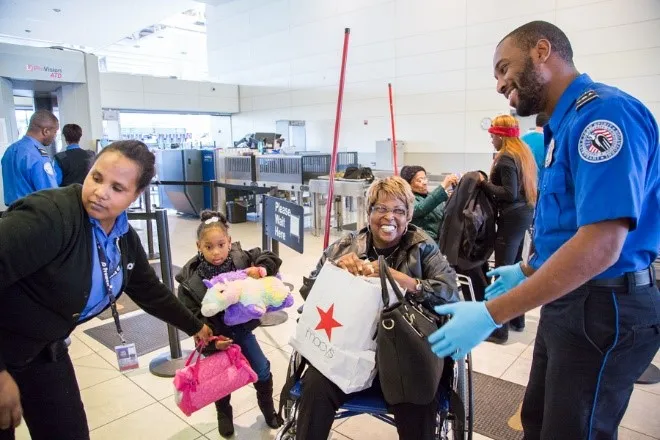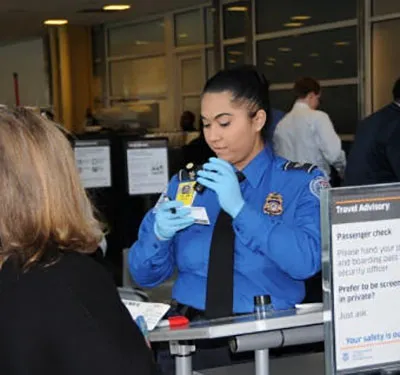The Transportation Security Administration (TSA) protects the nation’s transportation systems to ensure freedom of movement for people and commerce. TSA was created after the terrorist attacks on September 11, 2001, when – driven by a desire to prevent future attacks – tens of thousands of people joined TSA and committed themselves to its mission. TSA is responsible for screening approximately two million passengers a day, over 700 million a year, at nearly 440 U.S. airports. Over 44,000 Transportation Security Officers (TSOs) are responsible for the security of more than 20,000 domestic flights and 2,000 outbound international flights per day. TSOs screen 1.3 million checked items and 4.9 million carry-on items for explosives and other dangerous items daily. Here are some things you might not know about TSA:

Photo above, Officers complete passenger screening at Baltimore/Washington International Thurgood Marshall Airport. (Photo provided by TSA Public Affairs)
- TSA works with international partners to secure transportation not only in the U.S. but around the world.
In fiscal year 2016, TSA conducted 135 foreign airport assessments and nearly 1,900 inspections of air carriers offering flights directly to the U.S. from other countries. Information gathered during these visits enables TSA to identify specific vulnerabilities at last point of departure airports and develop strategies to reduce risk. In support of these efforts, TSA has 49 representatives who directly communicate with its foreign partners.
- Federal Air Marshals are on board an undisclosed number of flights to detect, deter and defeat criminal and terrorist activities in the air.
TSA deploys Federal Air Marshals on U.S.-flagged aircraft throughout the world, 365 days a year. The Federal Air Marshal Service is made up of law enforcement officers who receive specialized training to prepare for a unique and challenging working environment. Federal Air Marshals in the aviation sector operate in tight quarters at 30,000 feet and must meet some of the most demanding firearms requirements in federal government service.
- Passenger screening begins with Secure Flight.
TSA has 20 integrated layers to create a much stronger, safer system. You may not know that screening actually begins long before you arrive at the airport. After an individual makes a reservation, his or her name is checked at TSA’s state-of-the-art Secure Flight facilities – the first line of defense in ensuring that a known or suspected terrorist does not board an aircraft. The Secure Flight program collects the personal information necessary to conduct effective matching. Secure Flight then transmits screening instructions to the airlines to identify low-risk passengers eligible for TSA Pre✓®, individuals to be placed on the selectee list who are designated for enhanced screening, and those who will receive standard screening.
- TSA sends volunteers to disaster locations, such as the areas devastated by Hurricane Harvey.
TSA joins other DHS components and federal agencies to help FEMA with response and recovery support. These employees travel to disaster regions to provide assistance as part of the Surge Capacity Force. Nearly 700 TSA employees were deployed to the areas devastated by Hurricane Harvey. Starting just before Harvey hit land, TSA’s Critical Incident Management Group worked around the clock to assist Federal Security Directors and Federal Air Marshals in affected areas with logistics and coordination. Canine, VIPR, and Transportation Security Support Teams also made their way to Houston in support of local and federal efforts. Also, because of the support from National Deployment Officers around the country, TSA stood prepared to get airport security up and running in Houston after Harvey swept through the region.
- TSA also oversees the nation’s surface transportation system.
TSA is known mostly for its screening operations at U.S. airports, but did you know that TSA is also responsible for safeguarding the surface transportation sector? That’s over 4 million miles of roads, more than 611,000 bridges and nearly 140,000 miles of railroad tracks. TSA also supports maritime security efforts along approximately 12,000 miles of coastline and over 25,000 miles of navigable waterways.
- TSA secures and protects the nation’s pipeline system.
Did you know that TSA plays an important role in protecting the country’s 2.7 million miles of natural gas and oil pipelines? It even has a representative stationed in Anchorage, Alaska to lead the effort. Ninety-seven percent of the nation’s transportation sector runs on fuel from pipelines, and pipelines supply fuel for electrical generation and home heating needs. TSA works closely with the pipeline industry and provides them with guidelines and training materials for pipeline companies to increase security awareness and preparedness.
- DHS operates a laboratory where TSA tests explosives detection systems.
In April 2017, the DHS Science and Technology Directorate opened a new Test & Evaluation Laboratory building in Atlantic City, N.J. At this new facility, TSA has more lab space to test explosives detection systems. One of the laboratory’s primary responsibilities is to provide independent tests and evaluations of commercial explosives detection equipment and certify them for potential deployment in checked baggage and checkpoint environments.
- Veterans comprise a large percentage of TSA’s workforce.
Approximately 22 percent of TSA employees served in the U.S. Armed Forces, and in 2016, more than 62,000 military veterans participated in a survey that found TSA to be one of the top 10 veteran-friendly employers in the country.

Photo above, TSA agent inspecting ID before passengers enters checkpoint.(Photo provided by TSA Public Affairs)
TSA regularly engages veterans through targeted programs and events that underscore TSA’s support of our veterans.
For more fun facts about TSA please visit: https://www.tsa.gov/blog/2017/08/25/did-you-know-21-factoid-nuggets-you-might-not-know-about-tsa.
###
